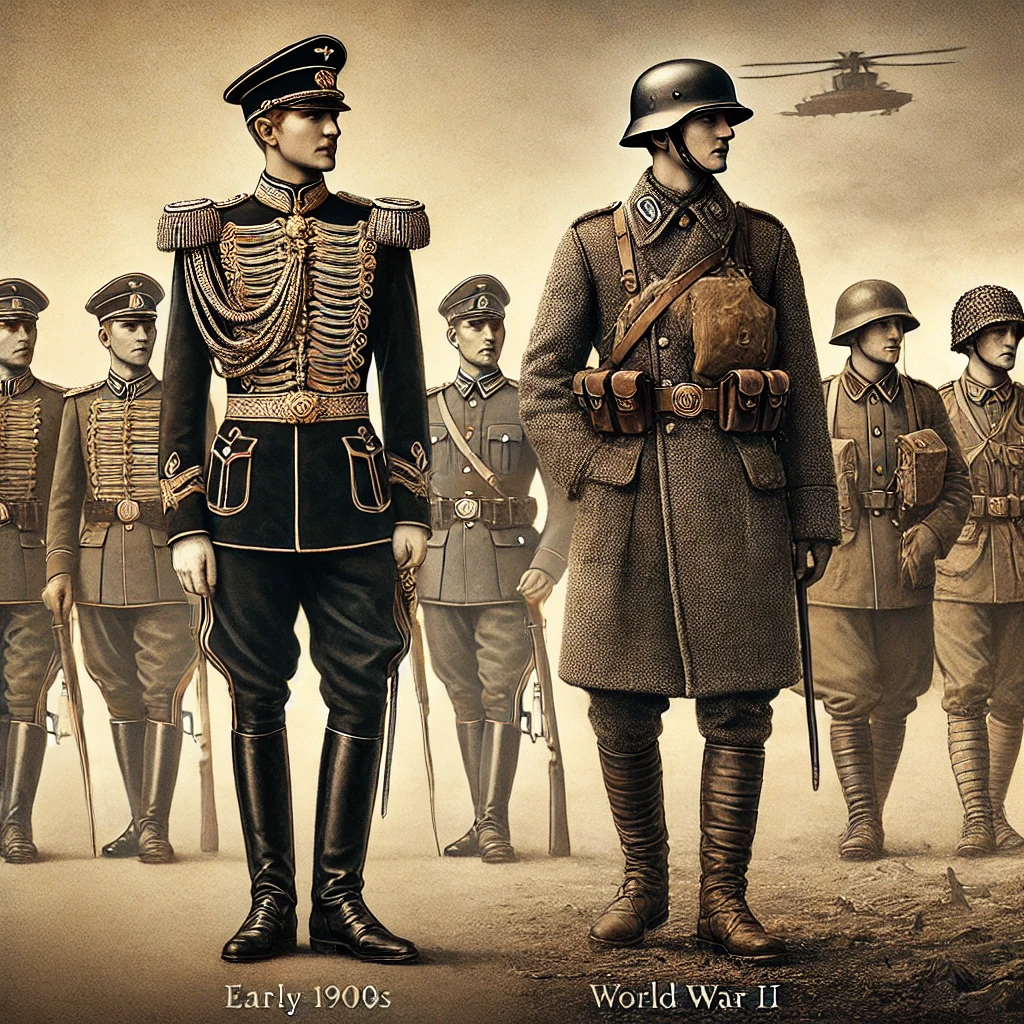
The Evolution of Military Uniforms: From Early 1900s German Tailoring to WWII British Battledre
Published on Mar 05, 2025
The Evolution of Military Uniforms: From Early 1900s German Tailoring to WWII British Battledress
Introduction
Military uniforms have always been more than just clothing—they symbolize power, discipline, and national identity. Over the centuries, these uniforms have evolved in response to technological advancements, battlefield necessities, and shifts in political landscapes. The early 1900s saw Germany’s military uniforms crafted with precision and tradition, reflecting the empire’s strong military heritage. Meanwhile, the British army’s WWII Battledress marked a turning point in uniform design, prioritizing practicality over formality.
In this article, we’ll explore the historical significance of German military attire in the early 1900s, the tailors who created these uniforms, and how British military fashion adapted to the demands of the Second World War.
German Military Uniforms in the Early 1900s: A Tradition of Elegance and Precision
The Role of Tailors in Military Uniform Production
In the early 20th century, German military uniforms were renowned for their precision and craftsmanship. Germany had a long-standing tradition of tailoring excellence, with skilled artisans meticulously designing uniforms that balanced durability with elegance. Unlike mass-produced uniforms of later decades, early German military attire was often handcrafted, ensuring a perfect fit and an immaculate appearance.
The tailors who made these uniforms were primarily located in major German cities like Berlin, Munich, and Hamburg. They worked closely with the government and military institutions, adhering to strict design regulations. Each regiment had specific uniform requirements, with variations in colour, insignia, and accessories that signified rank and division.
Distinct Features of Early 1900s German Military Uniforms
- Pickelhaube Helmet – One of the most recognizable elements of German military attire during this period was the Pickelhaube, a spiked helmet made of leather and reinforced with metal. It served both decorative and protective functions.
- Dark Blue & Field Grey Uniforms – German military uniforms were initially deep Prussian blue. Still, by the early 1900s, the shift towards field grey (Feldgrau) began, allowing for better camouflage in combat.
- Ornate Detailing & Buttons – Higher-ranking officers often had gold or silver embroidery on their tunics, with brass buttons signifying regimental identity.
- Wool Tunics & Breeches – Wool was the primary fabric, ensuring warmth in cold European climates and maintaining durability.
As World War I approached, German uniform designs started adapting for battlefield efficiency, replacing decorative elements with practical features.
World War I: The Transition from Style to Utility
World War I changed military fashion significantly, shifting from highly detailed uniforms to more functional attire. Soldiers needed outfits that provided better protection, mobility, and camouflage.
Changes in Military Attire During WWI
- Simplification of Uniforms – Ornate details were removed to make production faster and cheaper.
- Introduction of Steel Helmets – The Pickelhaube was replaced by the Stahlhelm in 1916, offering better protection against shrapnel and bullets.
- Mass Production – As the war intensified, uniforms were no longer tailored individually; they were mass-produced in factories.
Germany’s approach to military fashion in WWI set the stage for future wartime uniforms, leading to a focus on practicality that would continue into WWII.
WWII British Soldier Uniform: The Rise of the Battledress
Why Did Britain Introduce the Battledress?
Before World War II, British military uniforms followed traditional styles similar to those of World War I. However, the demands of modern warfare required a more practical and adaptable uniform. This led to the introduction of the Battledress in 1938, which was designed to be functional, durable, and easy to produce in large quantities.
Key Features of the WWII British Battledress
- Tunic and Trousers Set – The British Battledress wore a woollen tunic and trousers designed for warmth and comfort.
- Shorter Jackets – Unlike older long coats, the Battledress had a shorter jacket, making it more practical for movement in combat.
- Camouflage-Friendly Colors – The uniform came in khaki or brown shades, allowing soldiers to blend into their surroundings.
- P37 Webbing Equipment – Soldiers wore webbing harnesses over their uniforms to carry essential gear like ammunition, water bottles, and medical supplies.
- Beret or Steel Helmet – British soldiers wore berets or the Brodie helmet for head protection, depending on their role.
Impact of the British Battledress
The British Battledress set a precedent for military uniforms around the world. Its practical design was adopted by many armies and influenced post-war military fashion. Even today, elements of the WWII Battledress can be seen in modern military uniforms.
Comparing German and British Military Uniforms: 1900 vs. WWII
FeatureEarly 1900s German UniformsWWII British Battledress
Material Wool, heavy fabrics Wool-blend, lightweight
Fit Tailored, snug fit Loose, practical fit
Headgear Pickelhaube helmet, Brodie helmet, or beret
Colour Dark blue, later grey Khaki/brown for camouflage
Production Handmade by tailors Mass-produced in factories
Functionality Focused on appearance Designed for combat efficiency
Conclusion: The Evolution of Military Fashion
The transformation of military uniforms from the early 1900s to WWII highlights the impact of warfare on fashion. Germany’s early military uniforms reflected prestige and tradition, while the introduction of the British Battledress in WWII showcased the necessity of practicality and mass production.
Both eras contributed significantly to the development of modern military attire. Today’s armed forces continue to build on these historical innovations, incorporating new materials and technologies for enhanced protection and efficiency.
By understanding the evolution of these uniforms, we gain insight into the broader changes in military strategy, technology, and society itself. Whether for historical appreciation or collecting vintage military gear, these uniforms remain a testament to the changing face of warfare.
